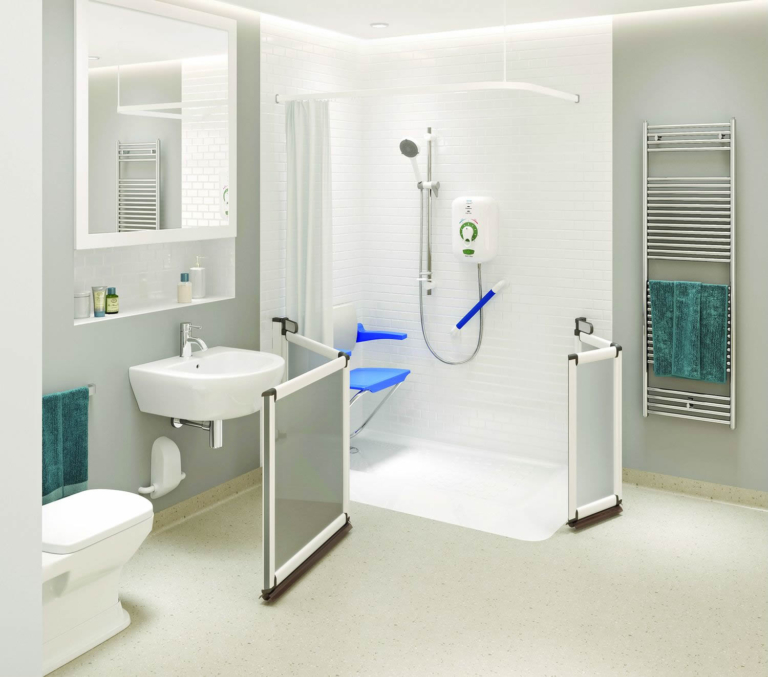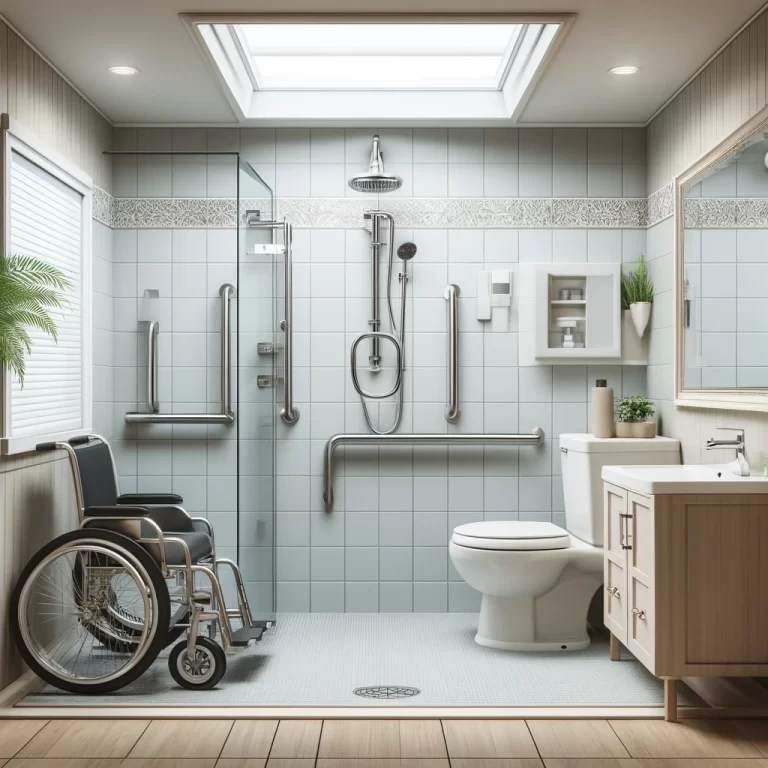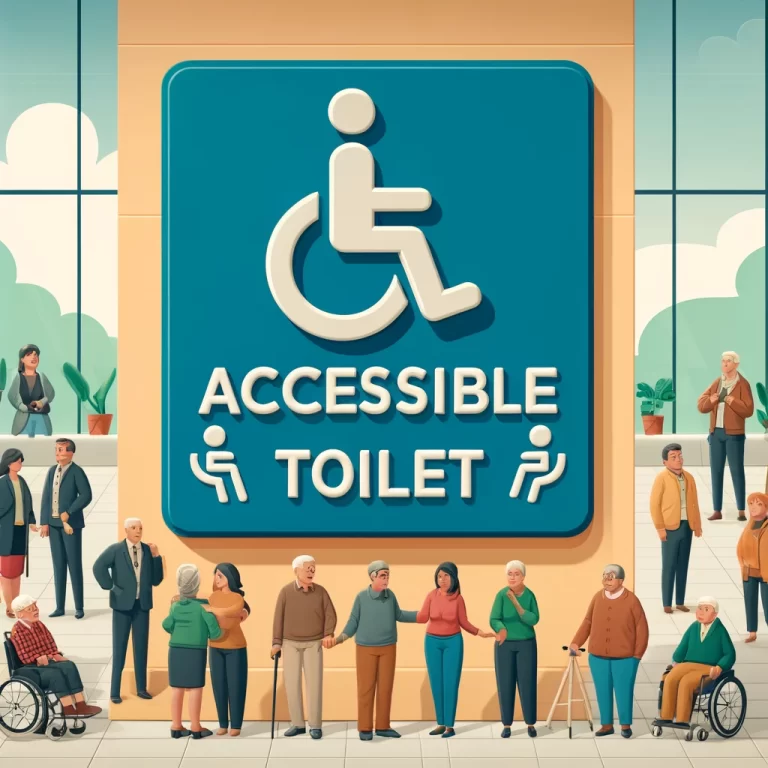How often should a disabled person shower
Showering is an essential part of daily hygiene for everyone, but it can be especially important for disabled individuals. Factors such as personal hygiene needs, skin conditions, mobility, and access to shower facilities all play a role in determining the frequency of showering for those with disabilities.
We will explore the different factors to consider when determining how often a disabled person should shower, as well as provide tips for making the showering experience more accessible and safe. Let’s learn more about the importance of showering for disabled individuals. Have a look at https://wetwallpanels.co.uk/

Why Is Showering Important for Disabled People?
Showering plays a crucial role in the overall well-being and health of disabled individuals, particularly those facing mobility challenges or skin conditions.
A soothing and refreshing shower not only helps in maintaining cleanliness but also promotes circulation and relaxation. For disabled persons, bathing regularly can prevent skin infections, reduce the risk of UTIs, and improve overall skin health. Proper hygiene is paramount in avoiding unpleasant odours and potential health issues. Showering aids in boosting self-esteem and confidence, providing a sense of independence and personal care. Elderly care facilities often prioritize customised shower routines to cater to individual needs and ensure optimal well-being. The calming effect of water and the feeling of cleanliness can greatly improve the quality of life for disabled individuals.
Factors to Consider for Showering Frequency for Disabled People
Determining the appropriate showering frequency for disabled individuals involves considering various factors such as personal hygiene needs, skin conditions, and mobility challenges.
Personal hygiene is crucial for overall health and well-being, especially for individuals with disabilities, as it helps prevent infections and maintain skin health. Elderly care often emphasizes the importance of regular bathing to prevent skin issues and infections.
Inadequate shower facilities can pose challenges for disabled individuals, making it essential to have accessible and suitable bathing areas. Ensuring proper bathing etiquette and assistance when needed is also important to promote cleanliness and comfort.
Personal Hygiene Needs
Meeting the personal hygiene needs of disabled individuals requires attentive care, effective communication, and adherence to appropriate bathing etiquette.
Providing adequate personal hygiene care for disabled individuals is crucial not only for physical well-being but also for their overall emotional and mental health. It is essential for carers to establish clear communication with the individual about their preferences and comfort levels when it comes to bathing routines. This communication helps uphold the person’s dignity and autonomy, fostering a sense of self-esteem and respect. Ensuring proper hygiene practices not only promotes physical health but also contributes to a positive self-image and social interactions.
Skin Conditions
Managing skin conditions among disabled individuals is essential to prevent infections such as UTIs and maintain skin health and integrity.
For disabled individuals facing mobility challenges, the showering routine is often a critical aspect of their hygiene management. Skin conditions can significantly impact the frequency of showers, as some skin conditions require daily cleansing to prevent flare-ups and infections.
- In elderly care settings, where skin fragility and sensitivity are common, proper hygiene practices become even more crucial to avoid skin breakdown and dermatological issues.
- Regular showers not only help in managing skin conditions effectively but also play a vital role in preventing secondary infections and promoting overall well-being.
Understanding the unique needs of disabled individuals and tailoring hygiene routines accordingly can greatly contribute to their quality of life and skin health.
Mobility and Independence
Enhancing mobility and independence for disabled individuals during showering routines is essential for promoting autonomy and well-being.
Addressing mobility issues not only fosters a sense of independence but also improves the overall quality of life for individuals in need of assistance. Providing the proper support and tools, such as grab bars, shower chairs, or handheld showerheads, can enhance safety and comfort during the showering process. Carers play a crucial role in offering the necessary assistance, allowing individuals to maintain their dignity and mobility.
Occupational therapists (OTs) often recommend specific techniques tailored to the individual’s unique challenges, enabling them to navigate the shower environment with ease. As individuals age, addressing mobility concerns becomes increasingly important to prevent accidents and promote overall well-being. By focusing on mobility during showering, individuals can experience a greater sense of control and independence in their daily activities, contributing to a higher quality of life.
Access to Adequate Shower Facilities
Ensuring access to suitable shower facilities equipped with necessary aids and equipment is vital for enabling disabled individuals to maintain personal hygiene effectively.
Accessible shower facilities play a crucial role in promoting independence and dignity for individuals with disabilities. Assistance bars, adjustable showerheads, and non-slip mats are just a few examples of essential equipment that can enhance safety and ease of use.
Modifications such as grab bars, shower seats, and barrier-free entryways help create a more inclusive and accommodating environment. Implementing these features not only ensures physical safety but also boosts confidence and self-esteem among users.
The process of designing and installing accessible shower facilities often involves collaboration with occupational therapists and accessibility experts to tailor solutions to specific needs, making it a comprehensive and thoughtful approach.
How Often Should a Disabled Person Shower?
Determining the optimal showering frequency for a disabled person involves considering factors like skin health, UTI prevention, and managing conditions like incontinence.
It is crucial to strike a balance between maintaining hygiene and preventing skin issues. For some individuals, daily showers are necessary to prevent infections and maintain cleanliness. For others, especially as they age, excessive washing can strip the skin of essential oils, leading to dryness and irritation.
Carers play a vital role in assessing the specific needs of the disabled person and adjusting the showering routine accordingly. It’s essential to take into account individual preferences and comfort levels, as well as any specific skin conditions that may require special attention.
Daily Showering
Daily showering may be recommended for some disabled individuals to maintain skin hygiene, prevent infections, and promote overall well-being.
For people with disabilities, especially those facing mobility challenges, regular showers can contribute significantly to their skin health by removing sweat, dirt, and bacteria. The warm water and gentle cleansing also help in improving blood circulation and reducing inflammation, which is important for maintaining healthy skin.
Showering can have positive psychological effects by boosting confidence and self-esteem. It is crucial to consider safety measures such as grab rails and non-slip mats to prevent falls, particularly among individuals with conditions like dementia. Providing adequate support and assistance during showers is essential for ensuring a comfortable and efficient personal care routine.
Showering every other day
Showering every other day may be suitable for disabled individuals with specific skin conditions, requiring assistance, or managing personal care routines.
When considering a bathing routine for disabled individuals, it is crucial to take into account their skin health. Frequent bathing can lead to dry skin and exacerbate conditions such as eczema. By showering every other day, the skin has the opportunity to retain more of its natural oils, promoting better overall skin health.
Disabled individuals often require assistance during showers, whether it be with physical support or guidance. This regular assistance plays a vital role in ensuring a safe and effective bathing routine, helping to prevent accidents and promote independence.
Carers play a significant role in facilitating bathing services for disabled individuals. They provide the necessary support, ensuring privacy and dignity are maintained throughout the process. This dedicated care enhances the overall bathing experience, making it a positive and comfortable aspect of personal hygiene routines.
By incorporating regular but not daily showers into the care routine of disabled individuals, the risk of skin infections can also be reduced. Over-bathing can strip the skin of its protective barrier, making it more susceptible to infections. Therefore, the practice of every other day showering can contribute to maintaining healthy skin and overall well-being.
Twice a Week Showering
having a wash twice a week
This routine allows them to ensure their safety during showering activities, as frequent transfers or movements can pose risks of falls or injuries. By planning and scheduling washes twice a week, these individuals can maintain personal hygiene standards without feeling overwhelmed by daily tasks. It also provides an opportunity for carers or family members to assist in a controlled environment, ensuring individual needs are met promptly and effectively.
Once a Week Showering
In certain cases, such as for bedridden individuals or those with limited mobility, showering once a week with appropriate skincare routines and caregiver assistance may be suitable.
When showering weekly, it is crucial to pay extra attention to skin care to prevent sebum build-up, which can lead to skin issues like rashes or infections. Caregivers should provide gentle cleansing using mild, non-irritating products and ensure thorough rinsing to avoid residue. Personalised hygiene routines must be in place, considering individual needs and preferences for a comfortable experience.
Having the right equipment is essential for safe and effective showering. Grab bars, shower chairs, and handheld shower heads can facilitate the process, providing support and stability. Regular communication between the caregiver and the individual is key to tailor the showering experience to meet specific requirements and maintain overall well-being.
Tips for Showering for Disabled People
Enhancing the showering experience for disabled individuals involves utilising practical tips such as using a shower chair, installing grab rails, and ensuring a safe and comfortable environment.
Adding a non-slip mat inside the shower area can provide extra stability and prevent slips and falls. Assistance should always be available if needed, whether from a carer, family member, or through specialised equipment like a shower buddy. Consider incorporating a handheld shower head for easier reach and manoeuvrability. Ensure privacy by installing curtains or doors that can be easily opened and closed. Investing in adjustable shower benches can accommodate different needs and preferences, aiding in both comfort and accessibility.
Utilise a shower chair or bench
Utilising a shower chair or bench can significantly enhance safety and comfort during the showering process for disabled individuals with mobility challenges.
Shower chairs provide crucial assistance by offering a stable and secure seating option, reducing the risk of slips and falls in wet environments. With a sturdy construction, these chairs ensure reliable support for individuals who may struggle with balance or standing for extended periods.
Shower chairs promote better hygiene practices by enabling individuals to shower independently without the need for constant supervision. This not only fosters a sense of dignity and privacy but also encourages autonomy in daily self-care routines.
When selecting a shower chair, it is essential to consider factors such as weight capacity, adjustable height settings, non-slip surface features, and portability for ease of use and storage. Investing in the right mobility equipment can make a significant difference in enhancing the overall showering experience for individuals with limited mobility.
Install Grab Bars for Safety
Installing grab rails in the shower area can improve stability, prevent slips, and offer valuable support for disabled individuals during showering routines.
These robust rails act as essential aids, not only enhancing balance and security but also promoting independence and confidence.
For individuals with limited mobility or strength, such as the elderly or those recovering from an injury, grab rails are crucial tools that facilitate safer shower experiences.
They provide a firm grip, minimising the risk of falls and allowing users to navigate the wet environment with ease.
Communication and understanding needs of individuals with special needs are met by incorporating grab rails, ensuring a sense of safety and dignity in the bathroom.
Consider Using a Handheld Showerhead
A hand-held shower head provides flexibility and control during showering for disabled individuals, allowing for improved mobility and personalised water flow adjustments.
For individuals with limited mobility, the ease of manoeuvring a hand-held shower head means they can reach all areas of their body without the need for additional support, promoting independence and privacy. The ability to adjust the flow and direction of water allows for a customised shower experience, catering to each individual’s specific needs and preferences. This level of control not only ensures a comfortable showering experience but also reduces the need for assistance from carers, give the power toing disabled individuals to carry out their shower routines with greater confidence and autonomy.
Use Non-Slip Mats
Non-slip mats are essential accessories in the bathroom to prevent falls, enhance safety, and create a secure showering environment for disabled individuals.
They offer crucial stability, especially for those with mobility issues like dementia patients, ensuring that they have a reliable foothold during showers. Carers also benefit from the peace of mind these mats provide, knowing their loved ones are protected from potential accidents.
Plus safety, non-slip mats contribute to a hygienic environment by reducing the risk of infections due to wet floors. By effectively draining water and providing a comfortable standing surface, these mats enhance the overall shower experience while prioritising well-being.
Have a Carer or Assistance Available
Having a carer or assistance available during showering routines is vital for ensuring safety, privacy, and support for disabled individuals who require additional help.
Carer support is essential not only for physical assistance but also for maintaining the individual’s dignity and emotional well-being. The presence of a carer allows the person being cared for to feel secure and respected, enhancing their overall showering experience. Privacy is crucial during such intimate tasks, and carers play a crucial role in ensuring that the individual feels comfortable and respected. By providing proper assistance with hygiene, carers contribute to improving the quality of life for those under their care.
Maintaining a sense of dignity during daily routines like showering is paramount for individuals with disabilities, and having a carer who is sensitive to their needs can make a significant difference in their well-being. Carers should approach showering routines with empathy and understanding, striving to uphold the individual’s dignity and autonomy throughout the process.
Proper assistance during showering helps prevent accidents or injuries, as carers can provide the necessary support and supervision to minimise risks. Ensuring the individual’s safety should always be a top priority for carers, and being present during the showering routine allows them to intervene promptly if any issues arise. Carer support during showering is not just about physical help; it is about creating a supportive and respectful environment that promotes the individual’s hygiene and well-being.
Frequently Asked Questions
How often should a disabled person shower?
The frequency of showering for a disabled person may vary depending on their individual needs and abilities. It is recommended to shower at least 2-3 times a week for hygiene purposes.
Are there any special considerations for showering that should be kept in mind for a disabled person?
Yes, depending on the disability, there may be certain accommodations or equipment needed for showering such as grab bars, shower chairs, or hand-held showerheads. It’s important to make sure the shower area is safe and accessible for the individual.
Can a disabled person shower daily?
It ultimately depends on the person’s physical capabilities and preferences. If daily showering is not feasible, sponge baths or other hygiene methods can be used to maintain cleanliness.
Is it okay for a disabled person to skip showering on certain days?
While maintaining good hygiene is important, it is also important to listen to the individual’s needs and abilities. If they are unable to shower on a certain day, sponge baths or other alternatives can be used to freshen up.
What are some tips for making showering easier for a disabled person?
Some suggestions may include installing handrails or grab bars for stability, using a shower chair or stool, and having someone assist the individual if needed. It’s also helpful to have all necessary items (soap, shampoo, etc.) within reach to minimise movement.
Is there a specific time of day that is best for a disabled person to shower?
The best time may vary for each individual, but some may find it easier to shower in the morning when they have more energy, while others may prefer to shower in the evening before bed. It’s important to find a time that works best for the individual’s needs and schedule.







